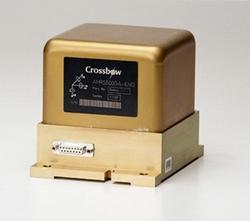Wed, Feb 26, 2003
 Crossbow Technology has just received FAA
certification for the AHRS500GA, the first stand-alone
micro-electro-mechanical system (MEMS) attitude heading reference
system (AHRS). Stand-alone means the Crossbow AHRS operates
independently and does not require Air Data or GPS inputs for
correct operation.
Crossbow Technology has just received FAA
certification for the AHRS500GA, the first stand-alone
micro-electro-mechanical system (MEMS) attitude heading reference
system (AHRS). Stand-alone means the Crossbow AHRS operates
independently and does not require Air Data or GPS inputs for
correct operation.
Only Standalone FAA Certified MEMS AHRS
The Crossbow AHRS500GA is a high performance, solid-state
attitude and heading reference system intended for general aviation
aircraft. This high reliability inertial system provides attitude
and heading measurement with static and dynamic accuracy superior
to traditional spinning mass vertical and directional gyros. Dean
Johnson, Vice President for Inertial Systems, says "Crossbow is the
first to offer the General Aviation pilot the reliability of
solid-state MEMS sensors in a low cost AHRS that meets all the FAA
TSO certification requirements. The AHRS500 is designed for the
future and has passed the tough new multiple lightning strike test
as part of its qualification testing."
Automotive Sensor Technology Harnessed
 The sensor technology of the AHRS500 was developed
for the automotive industry, which makes the technology highly
reliable and potentially affordable for general aviation pilots.
The raw performance of these devices is geared toward fairly coarse
inertial applications, such as skid detection. John Crawford, vice
president of sales for Crossbow, says "Crossbow started with the
automotive industry's low-cost, highly reliable, but low-performing
sensors and invested six years,of R&D in calibration
approaches, packaging, software algorithms and environmental
design. The result is a flight-proven AHRS that requires no
additional or aiding input from Air Data or GPS to meet FAA
performance requirements. That is the real breakthrough here."
The sensor technology of the AHRS500 was developed
for the automotive industry, which makes the technology highly
reliable and potentially affordable for general aviation pilots.
The raw performance of these devices is geared toward fairly coarse
inertial applications, such as skid detection. John Crawford, vice
president of sales for Crossbow, says "Crossbow started with the
automotive industry's low-cost, highly reliable, but low-performing
sensors and invested six years,of R&D in calibration
approaches, packaging, software algorithms and environmental
design. The result is a flight-proven AHRS that requires no
additional or aiding input from Air Data or GPS to meet FAA
performance requirements. That is the real breakthrough here."
Viable Alternative To Spinning Gyros
In fact, this technology permits general aviation pilots to have
the same attitude and heading benefits of the ring laser gyro-based
INS system in a transport category aircraft. "The difference is
that an INS system may cost upwards of $100,000, but it operates on
the same principle. The AHRS500 provides a new and clear
alternative to unreliable spinning gyros or costly INS systems,"
says Crawford. The AHRS500 also includes a comprehensive built-in
test function, similar to high-end INS systems, that continuously
monitors the AHRS for proper operation.
Crossbow flight testing of the AHRS500 against a high-end
inertial navigation system (INS) proves the accuracy of the AHRS500
is better than that of the vacuum driven gyros in most aircraft.
The AHRS500 is designed to meet all FAA requirements and is
certified to TSO 4 (Bank and Pitch) and 6 (Heading).
More News
Aero Linx: International Federation of Airworthiness (IFA) We aim to be the most internationally respected independent authority on the subject of Airworthiness. IFA uniquely combi>[...]
Ultrahigh Frequency (UHF) The frequency band between 300 and 3,000 MHz. The bank of radio frequencies used for military air/ground voice communications. In some instances this may >[...]
A Few Questions AND Answers To Help You Get MORE Out of ANN! 1) I forgot my password. How do I find it? 1) Easy... click here and give us your e-mail address--we'll send it to you >[...]
From 2019 (YouTube Edition): Learning To Paint Without Getting Any On Your Hands PPG's Aerospace Coatings Academy is a tool designed to teach everything one needs to know about all>[...]
Also: Sustainable Aircraft Test Put Aside, More Falcon 9 Ops, Wyoming ANG Rescue, Oreo Cookie Into Orbit Joby Aviation has reason to celebrate, recently completing its first full t>[...]
 ANN's Daily Aero-Linx (05.06.25)
ANN's Daily Aero-Linx (05.06.25) ANN's Daily Aero-Term (05.06.25): Ultrahigh Frequency (UHF)
ANN's Daily Aero-Term (05.06.25): Ultrahigh Frequency (UHF) ANN FAQ: Q&A 101
ANN FAQ: Q&A 101 Classic Aero-TV: Virtual Reality Painting--PPG Leverages Technology for Training
Classic Aero-TV: Virtual Reality Painting--PPG Leverages Technology for Training Airborne 05.02.25: Joby Crewed Milestone, Diamond Club, Canadian Pilot Insurance
Airborne 05.02.25: Joby Crewed Milestone, Diamond Club, Canadian Pilot Insurance




